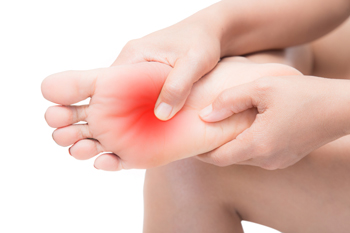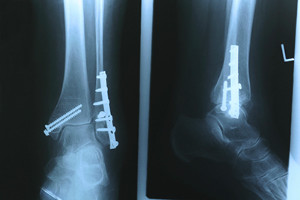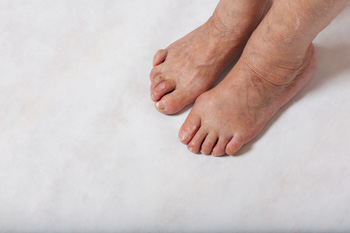Items filtered by date: January 2020
Caring for Your Diabetic Neuropathy
 It’s very common for those with diabetes to experience nerve damage. This may cause what is known as diabetic neuropathy, which often affects the feet. With this condition, it can be very difficult to feel if you have developed a wound. If these small injuries are not felt, it’s likely they will go untreated, which can be incredibly dangerous as that may lead to an infection, or further foot complications. To best care for your neuropathy, it’s suggested that you keep your blood sugar at a healthy level, check your feet daily, and refrain from walking barefoot. It is also advised that you wear protective footwear as an extra support for your feet. If you begin to notice symptoms such as a burning or tingling feeling in your feet, we recommend that you consult with a podiatrist as soon as possible for an advised treatment plan.
It’s very common for those with diabetes to experience nerve damage. This may cause what is known as diabetic neuropathy, which often affects the feet. With this condition, it can be very difficult to feel if you have developed a wound. If these small injuries are not felt, it’s likely they will go untreated, which can be incredibly dangerous as that may lead to an infection, or further foot complications. To best care for your neuropathy, it’s suggested that you keep your blood sugar at a healthy level, check your feet daily, and refrain from walking barefoot. It is also advised that you wear protective footwear as an extra support for your feet. If you begin to notice symptoms such as a burning or tingling feeling in your feet, we recommend that you consult with a podiatrist as soon as possible for an advised treatment plan.
Neuropathy
Neuropathy can be a potentially serious condition, especially if it is left undiagnosed. If you have any concerns that you may be experiencing nerve loss in your feet, consult with Leonora Fihman, DPM from California. Our doctor will assess your condition and provide you with quality foot and ankle treatment for neuropathy.
What Is Neuropathy?
Neuropathy is a condition that leads to damage to the nerves in the body. Peripheral neuropathy, or neuropathy that affects your peripheral nervous system, usually occurs in the feet. Neuropathy can be triggered by a number of different causes. Such causes include diabetes, infections, cancers, disorders, and toxic substances.
Symptoms of Neuropathy Include:
- Numbness
- Sensation loss
- Prickling and tingling sensations
- Throbbing, freezing, burning pains
- Muscle weakness
Those with diabetes are at serious risk due to being unable to feel an ulcer on their feet. Diabetics usually also suffer from poor blood circulation. This can lead to the wound not healing, infections occurring, and the limb may have to be amputated.
Treatment
To treat neuropathy in the foot, podiatrists will first diagnose the cause of the neuropathy. Figuring out the underlying cause of the neuropathy will allow the podiatrist to prescribe the best treatment, whether it be caused by diabetes, toxic substance exposure, infection, etc. If the nerve has not died, then it’s possible that sensation may be able to return to the foot.
Pain medication may be issued for pain. Electrical nerve stimulation can be used to stimulate nerves. If the neuropathy is caused from pressure on the nerves, then surgery may be necessary.
If you have any questions, please feel free to contact our offices located in Encino and Brentwood, Los Angeles, CA . We offer the newest diagnostic and treatment technologies for all your foot care needs.
Protective Boots and Stress Fractures
 The bones in your foot which connect the ankle to the toes are referred to as the metatarsal bones. These bones can be affected if a stress fracture occurs. Stress fractures can be a common injury among people who frequently run or participate in jumping activities. Additionally, patients who have medical conditions that include osteoporosis or arthritis may be prone to developing this condition. It is considered to be a hairline fracture, and can cause considerable pain and discomfort. After a proper diagnosis is performed, which typically consists of having a bone scan or an MRI taken, treatment can begin. This may involve wearing a protective boot as the healing process takes place. Mild relief may be found when the affected foot is elevated, as this may help to reduce existing swelling. If you have a stress fracture, it is strongly recommended that you consult with a podiatrist who can properly treat this condition.
The bones in your foot which connect the ankle to the toes are referred to as the metatarsal bones. These bones can be affected if a stress fracture occurs. Stress fractures can be a common injury among people who frequently run or participate in jumping activities. Additionally, patients who have medical conditions that include osteoporosis or arthritis may be prone to developing this condition. It is considered to be a hairline fracture, and can cause considerable pain and discomfort. After a proper diagnosis is performed, which typically consists of having a bone scan or an MRI taken, treatment can begin. This may involve wearing a protective boot as the healing process takes place. Mild relief may be found when the affected foot is elevated, as this may help to reduce existing swelling. If you have a stress fracture, it is strongly recommended that you consult with a podiatrist who can properly treat this condition.
Activities where too much pressure is put on the feet can cause stress fractures. To learn more, contact Leonora Fihman, DPM from California. Our doctor can provide the care you need to keep your pain free and on your feet.
Dealing with Stress Fractures of the Foot and Ankle
Stress fractures occur in the foot and ankle when muscles in these areas weaken from too much or too little use. The feet and ankles then lose support when walking or running from the impact of the ground. Since there is no protection, the bones receive the full impact of each step. Stress on the feet can cause cracks to form in the bones, thus creating stress fractures.
What Are Stress Fractures?
Stress fractures occur frequently in individuals whose daily activities cause great impact on the feet and ankles. Stress factors are most common among:
- Runners
- People affected with Osteoporosis
- Tennis or basketball players
- Gymnasts
- High impact workouts
Symptoms
Pain from the fractures occur in the area of the fractures and can be constant or intermittent. It will often cause sharp or dull pain with swelling and tenderness. Engaging in any kind of activity which involves high impact will aggravate pain.
If you have any questions please feel free to contact our offices located in Encino and Brentwood, Los Angeles, CA . We offer the newest diagnostic and treatment technologies for all your foot and ankle needs.
Orthotics May Help Your Hammertoe
 A hammertoe is a painful foot condition in which the toe bends downward, creating a hammer-like shape. They are normally caused by wearing shoes that are too tightly fitted, and may also be accompanied by the development of a bunion. In order to help straighten, and relieve the pain that comes with having a hammertoe, it may be useful to look into wearing orthotics. Some common orthotics used to help hammertoes include toe wraps. Toe wraps are elastic bandages with a Velcro strap, used to bind the hammertoe together with the toe next to it. Toe socks are socks that have five holes for each toe that help to keep them separated. Toe crest pads are also helpful, in that they wrap around the hammertoe and aid in preventing the toes from overlapping. For more information on orthotics and ways to help treat a hammertoe, we recommend you consult with a podiatrist for an advised treatment plan and professional care.
A hammertoe is a painful foot condition in which the toe bends downward, creating a hammer-like shape. They are normally caused by wearing shoes that are too tightly fitted, and may also be accompanied by the development of a bunion. In order to help straighten, and relieve the pain that comes with having a hammertoe, it may be useful to look into wearing orthotics. Some common orthotics used to help hammertoes include toe wraps. Toe wraps are elastic bandages with a Velcro strap, used to bind the hammertoe together with the toe next to it. Toe socks are socks that have five holes for each toe that help to keep them separated. Toe crest pads are also helpful, in that they wrap around the hammertoe and aid in preventing the toes from overlapping. For more information on orthotics and ways to help treat a hammertoe, we recommend you consult with a podiatrist for an advised treatment plan and professional care.
Hammertoe
Hammertoes can be a painful condition to live with. For more information, contact Leonora Fihman, DPM from California. Our doctor will answer any of your foot- and ankle-related questions.
Hammertoe is a foot deformity that affects the joints of the second, third, fourth, or fifth toes of your feet. It is a painful foot condition in which these toes curl and arch up, which can often lead to pain when wearing footwear.
Symptoms
- Pain in the affected toes
- Development of corns or calluses due to friction
- Inflammation
- Redness
- Contracture of the toes
Causes
Genetics – People who are genetically predisposed to hammertoe are often more susceptible
Arthritis – Because arthritis affects the joints in your toes, further deformities stemming from arthritis can occur
Trauma – Direct trauma to the toes could potentially lead to hammertoe
Ill-fitting shoes – Undue pressure on the front of the toes from ill-fitting shoes can potentially lead to the development of hammertoe
Treatment
Orthotics – Custom made inserts can be used to help relieve pressure placed on the toes and therefore relieve some of the pain associated with it
Medications – Oral medications such as anti-inflammatories or NSAIDs could be used to treat the pain and inflammation hammertoes causes. Injections of corticosteroids are also sometimes used
Surgery – In more severe cases where the hammertoes have become more rigid, foot surgery is a potential option
If you have any questions please contact our offices located in Encino and Brentwood, Los Angeles, CA . We offer the newest diagnostic and treatment technologies for all your foot and ankle needs.
Tips on How to Choose the Right Shoe for You
 When it comes to purchasing shoes, you want to ensure that you are getting both comfort and quality out of your footwear. To make sure your shoes are the perfect fit for you, it is recommended that you measure your feet beforehand, that way you have an idea of what size shoe will best fit your feet. A great tip to make sure you’re getting the most accurate measurement is to measure your feet at the end of the day, when they are typically at their largest. By doing this, you’re avoiding purchasing shoes that may be too small and will no longer properly fit your feet as the day goes on. It may also be helpful to wear a pair of socks you would normally wear with the shoes you’re looking into buying, that way you can tell if the shoes fit with your sock choice, or if they are too small. By picking the correct shoe size you may be preventing the development of foot complications such as hammertoes, blisters, and bunions. For more tips on how to choose the best shoe for you, we recommend you speak with a podiatrist for professional advice.
When it comes to purchasing shoes, you want to ensure that you are getting both comfort and quality out of your footwear. To make sure your shoes are the perfect fit for you, it is recommended that you measure your feet beforehand, that way you have an idea of what size shoe will best fit your feet. A great tip to make sure you’re getting the most accurate measurement is to measure your feet at the end of the day, when they are typically at their largest. By doing this, you’re avoiding purchasing shoes that may be too small and will no longer properly fit your feet as the day goes on. It may also be helpful to wear a pair of socks you would normally wear with the shoes you’re looking into buying, that way you can tell if the shoes fit with your sock choice, or if they are too small. By picking the correct shoe size you may be preventing the development of foot complications such as hammertoes, blisters, and bunions. For more tips on how to choose the best shoe for you, we recommend you speak with a podiatrist for professional advice.
Finding a properly-fitting shoe is important in reducing injuries and preventing foot problems. For more information about treatment, contact Leonora Fihman, DPM from California. Our doctor will treat your foot and ankle needs.
Proper Shoe Fitting
A common concern when it comes to foot health, having properly fitted shoes can help prevent injuries to the foot. Out feet affect our posture and gait, which in turn affects the biomechanics and overall bodily structure. With 33 joints, 26 bones, and over 100 ligaments, the potential for serious injury is much greater than one realizes. Although the feet cease growth in adulthood, they still change shape as they mature. Here are some factors to consider when it comes to investing in proper fitting shoes:
- Be sure the shoes fit correctly right away
- Ensure the ball of your foot fits comfortably in the widest portion of the shoes
- Even though they may look fashionable, improper fitting shoes can either create adverse conditions or exacerbate existing ones you may already have
- Walk along a carpeted surface to ensure the shoes comfortably fit during normal activity
Keeping in mind how shoes fit the biomechanics of your body, properly-fitting shoes are vitally important. Fortunately, it is not difficult to acquire footwear that fits correctly. Be sure to wear shoes that support the overall structure of your body. Do your feet a favor and invest in several pairs of well-fitted shoes today.
If you have any questions please feel free to contact our offices located in Encino and Brentwood, Los Angeles, CA . We offer the newest diagnostic and treatment technologies for all your foot and ankle needs.

